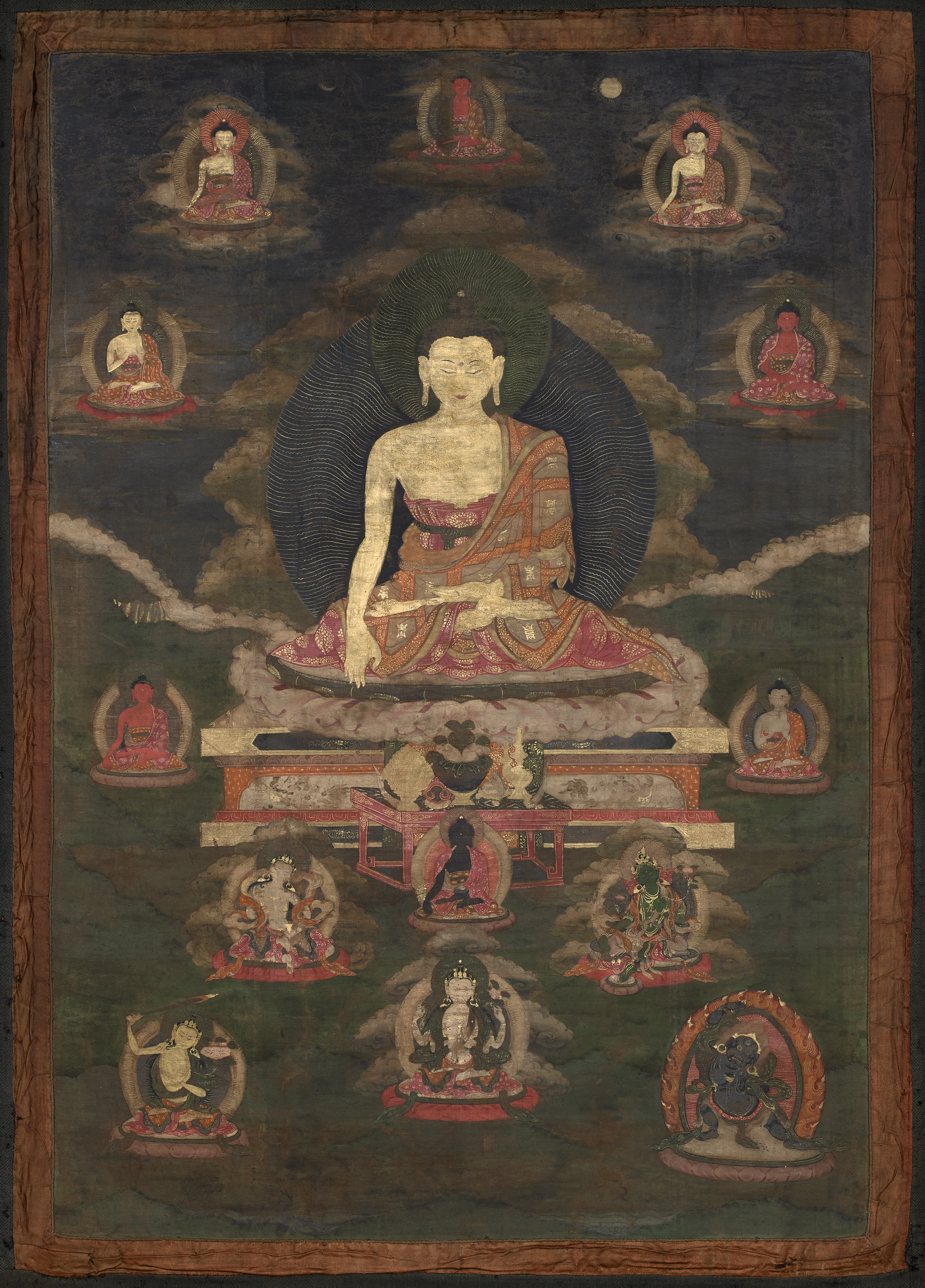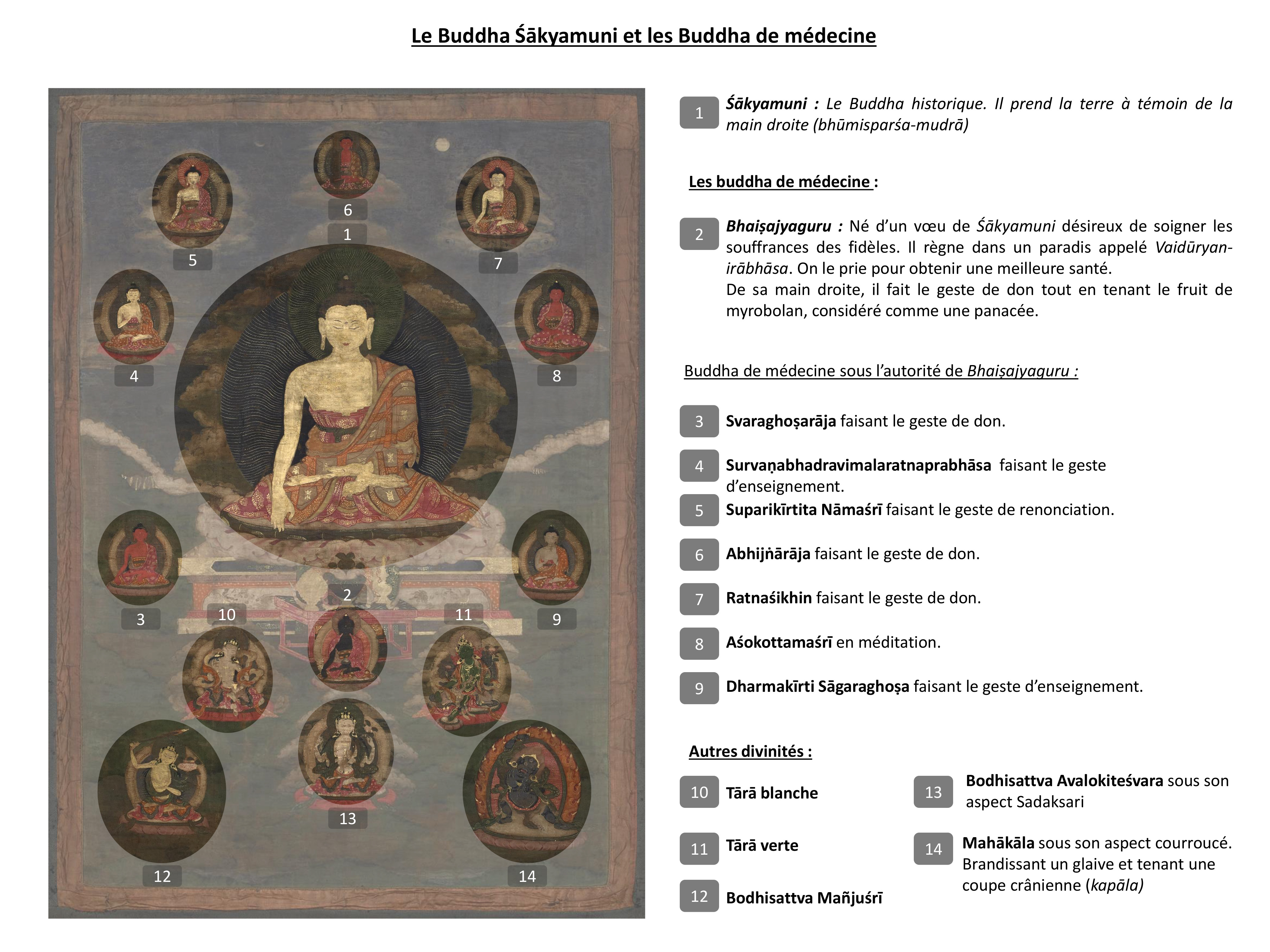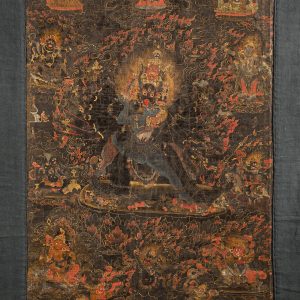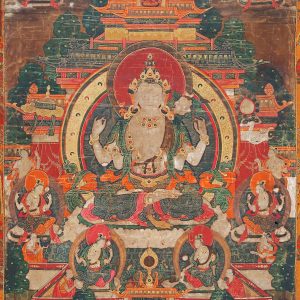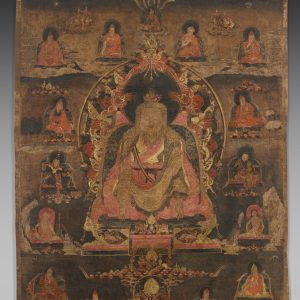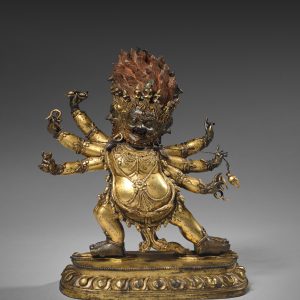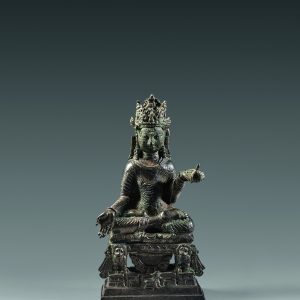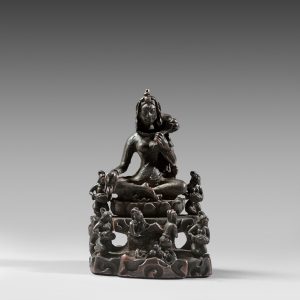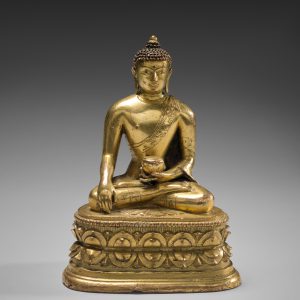Buddha Śākyamuni and the medicine Buddha
42 000,00€
Tempera on canvas
Tibet
First half of 17th century
D. 90 x 62 cm or 35 ½ x 24 ½ in
Description
In the center of the composition reigns Śākyamuni, the historic Buddha, his right hand making the earth witness gesture (bhūmisparśa mudra). Below him is Bhaisajyaguru and around him the other medicine Buddhas.
The main Sanskrit text concerning Bhaisajyaguru, the Bhaisajyaguruvai ūryaprabhā sūtra, relates how this buddha was born from a wish by Śākyamuni, who wanted to care for the suffering of the creatures of the world. Bhaisajyaguru reigns over a paradise to the east called Vaidūryanirbhāsa. Modeled after the Pure Land of Amitabha which tradition says is in the west, this paradise is its geographic opposite. Many parallels with the Amitabha cycle seem to indicate that this cult arose at a later date.
The most ancient translation in Chinese of a sutra concerning Bhaisajyaguru dates from the 4th century. It is not known when the cult was introduced in Tibet. The Bhaisajyaguruvaidūryaprabhā sūtra, which allows worshippers to enter his paradise, is recited in the land of snow. Prayers to Bhaisajyaguru ask for better health.
With his right hand, Bhaisajyaguru makes the gift-giving gesture while holding the myrobolan fruit, which is considered to be a panacea. The god’s complexion is blue, the color of the vaidurya gem, identified as being either beryl or lapis lazuli. He is leading a group of several other therapist buddhas. These characters surround Śākyamuni. Their number varies depending on the tradition involved: either eight in all, as here, or eight not counting Bhaisajyaguru. Their personalities also vary. The list found in the Ngor mandalas (first half of the 15th century), as related by Theresia Hofer (2014, p. 272), is different from that of the woodcuts of the Three Hundred Icons (sKu-brnyam sum-brgya) reproduced by Lokesh Chandra (1991, pp. 730-732, No. 136-144). Originally the Three Hundred Icons were made in Beijing for the dGe-lugs-pa church in China, Mongolia and Tibet, for scholastic purposes and as part of justificatory politics designed to pacify Mongolia. Decreed by the Emperor Qianlong (1736-1795), it was put into practice by the Grand Lama of Beijing Rol-pa’i-rdo-rje (1717-1778), who wrote the preface for the first edition. These representations were widespread and became the standard in most of the lamaic world, eclipsing other traditions.
Comparing the list supplied by T. Hofer, that by L Chandra and the buddhas shown on this painting, it can be seen that the buddhas don’t follow strictly the order of the cardinal points and the intermediary points of the Ngor mandalas; their colors are less subtle than those mentioned by T. Hofer. Our sources say nothing about the complexion of some or their traditional position in space. The hypotheses presented here are the most plausible ones, but remain open to comment or correction.
Starting from Bhaisajyaguru and moving around Buddha Śākyamuni in the auspicious direction (pradaksinam), holding the object of veneration in the right hand, we find the following Buddhas. At the throne, Svaraghosarāja (sGro-dbyangs rgyal-po) making the gift-giving gesture. At the head stands Survanabhadravimalaratnaprabhāsa (gSer-bzong dri-med rin-chen-snang) with reddish-yellow skin, making the teaching gesture with both hands and located to the west. Higher up, we recognize the golden Suparikīrtita Nāmaśrī (mTshan-legs yongs-sgrags-dpal), making the renunciation gesture (hand out, palm turned upward), corresponding to the south. At the top of the composition reigns Abhijnārāja (mNgon-mkyen rgyal-po), red like coral, making the gift-giving gesture, corresponding to the northeast. Lower down, on the right of the composition, we find, in succession, Ratnaśikhin (Rin-chen gtsug-tor-cam) – undoubtedly the Ratnacandrarāja mentioned by T. Hofer – with yellow skin, making the gift-giving gesture – here of renunciation – and which may correspond to the southwest. Below that, Aśokottamaśrī (Myang-ngan-med mchog-dpal), with a pale red complexion and related to the northwest, is meditating. Finally, below that, with pink skin according to texts, Dharmakīrti Sāgaraghosa (Chos-sgrags rgya-mtsho‘i dbyangs) makes the teaching gesture with both hands and corresponding to the north. Variants are noticeable both compared to the list of Ngor mandalas and to the woodcuts of the Three hundred icons, and following another ritual and textual tradition.
There are several deities in the lower section of the painting. On either side of Bhaisajyaguru, we recognize the two Tara goddesses, white and green. In the lower left corner is bodhisattva Maṅjuśrī, in the middle bodhisattva Avalokiteśvara in his Saḍakṣari manifestation, and finally in the lower right corner a god with an angry look and blue skin brandishing a sword and holding a skullcup (kāpala), which is probably meant to be Mahākāla.
The painting, with its artful subtlety, is characteristic of the sMan-bris style.
Provenance: Private collection, Belgium, since 1987.
Art Loss Register Certificate, ref. S00106959.
- Chandra, Lokesh, Buddhist Iconography, A compact Edition. New Delhi : International Academy of Indian Culture- Aditya Pradaksinam, 1991
- Hofer, Theresia, (Ed.), Bodies in Balance. The Art of Tibetan Medecine. New York : Rubin Museum of Art, 2014

